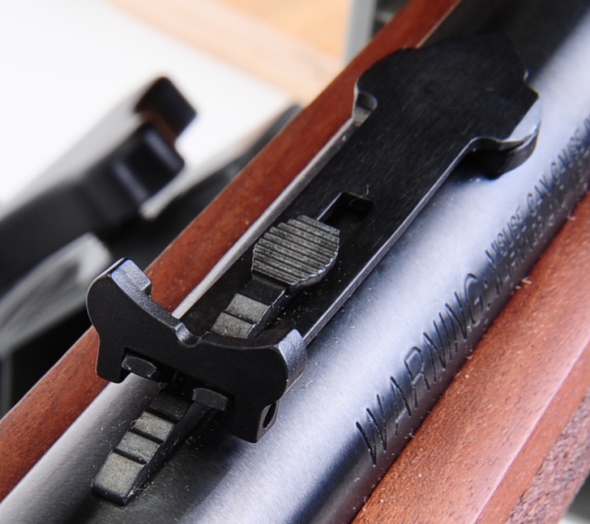 I like classic design lever action rifles, particularly the most recent generation with high reliability of function and bolt action like accuracy. I actually like semi-buckhorn rear sights and hooded bead front sights. At the range, or out hunting where there might be time for a well considered shot, they are terrific. That little “U” notch will provide critical aim, however, under poor lighting conditions or against a dark background, particularly in concert with running game, they are sometimes problematic.
I like classic design lever action rifles, particularly the most recent generation with high reliability of function and bolt action like accuracy. I actually like semi-buckhorn rear sights and hooded bead front sights. At the range, or out hunting where there might be time for a well considered shot, they are terrific. That little “U” notch will provide critical aim, however, under poor lighting conditions or against a dark background, particularly in concert with running game, they are sometimes problematic.
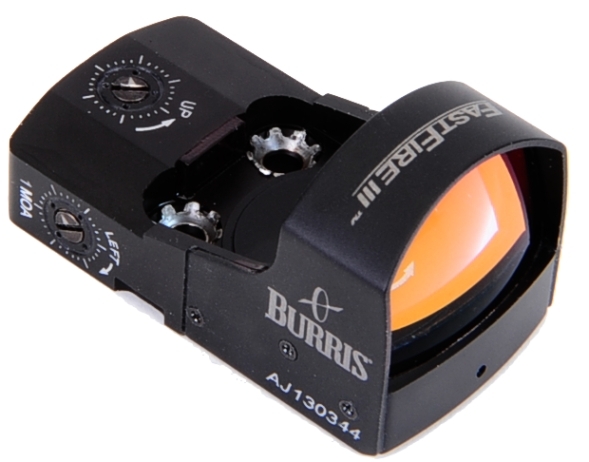
The second issue of sorting out the good products from the not so good was not as simple, but eventually the desirable characteristics came to the surface. The first issue was parallax. Cheaply made red dot sights, particularly those enclosed in a tube, can have a good deal of parallax. They requires the shooter’s eye to be perfectly in line with a sight’s optical center, which defeats the primary benefit of a reflex sight, speed. Good red dot sights should allow the shooter to keep both eyes opened for an unlimited field of view, and whether looking from the side of the image frame or looking down the center the shooter should still score a hit. The only requirement should be placing the dot on the target before pulling the trigger.
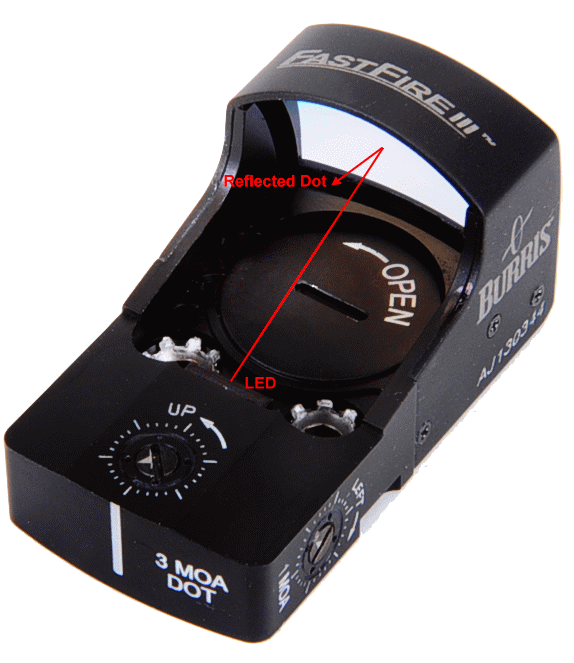
Like products costing 2 to 3 times the price of the Burris unit, the FastFire III has a two element, multi coated front lens that reflects and then refracts light straight back to the shooter. Both lenses are multicoated outside and the narrow band reflective surface is sandwiched, protected, between the two elements. The LED is positioned closer to line of sight than in closed tube sights, and the viewing lens is angled rearward slightly to minimize the angle of incidence of the projected and reflected red dot.
If there is anything noticeable about the optics when viewed on the bench, it is a slight blue coloration at the extreme top edge of the viewing lens. This is typically caused by the use of cast rather than ground glass optics, however, the ground glass units generally fall into the $700 – $800 range, while the Burris FastFire III is typically priced without mounts in the $225 – $250 range… which means I found the blue cast to be an exceptionally attractive feature.
FastFire II Vs FastFire III
For folks familiar with the FastFire II, the FastFire III offers some significant improvements. The FastFire III dot is now available optionally as 3 MOA or 8 MOA products rather than only with the FastFire II’s 4 MOA dot. This makes the III a little quicker on target and less obscuring of a target at longer ranges with the small dot and fast in short range target acquisition when ordered with the large dot. Access to the 10,000 hour battery has been moved to the top of the unit, rather than on the bottom side where the base has to be removed for service as is the case with the II.
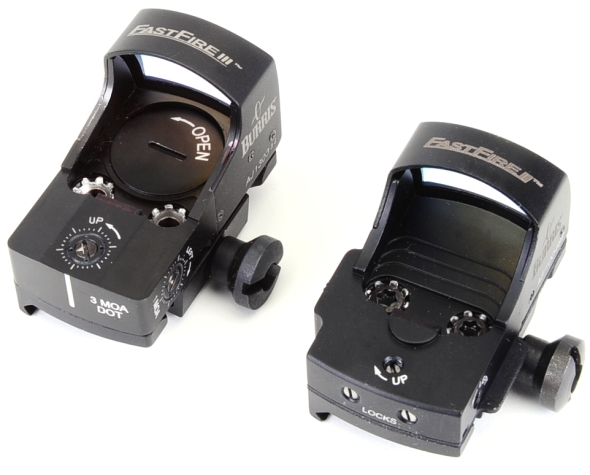
Windage and elevation adjustment have been vastly improved, beefed up and no longer require a scaled wheel to be attached for measured adjustment. FastFire III increment of adjustment is 1 MOA and lock screws are no longer required. The left side power button is now multi function. The FastFire II has auto brightness control, where the FastFire III has auto and step setting; auto, high, medium and low brightness. Repeat depression of the button cycles the brightness settings. No more taping light sensors to brighten the dot as it appears the auto brightness function has been more realistically recalibrated. More general specifications:
|
Burris FastFire III #300234 |
|
| Included: | |
|
FastFire III |
|
|
Torx Wrench |
|
|
Protective Cover |
|
|
Battery 3V CR1632 |
|
|
Weaver/Picatinny Mount |
|
|
Instructions |
|
| Specifications: | |
| Magnification | 1.07x |
| Sight Window | 21mmx15mm |
| Elevation Adjustment | 190″@100 Yards |
| Windage Adjustment | 190″@100 Yards |
| Adjustment Increment | 1 MOA |
| Subtension of Aiming Dot | 3 MOA |
| Recoil Resistance | 1000+ Gs |
| Operating Temperature Range | -10ºF to +130ºF |
| Storage Temperature Range | -40ºF to +160ºF |
| Dimensions (LxWxH) | 1.9″x1.0″x1.0″ |
| Weight | 0.9 Oz. |
| Parallax Free | 150 yards |
A couple of notes regarding construction. The unit is sealed which keeps dust, water and snow out. The FastFire III is listed as submersible with the note that if submerged in salt water, the unit should be flushed off with distilled water to protect the unit’s finish and optical coatings. As far as toughness goes, the FastFire III mechanical parts are made of a combination of stainless steel, bronze and anodized aluminum. Because of its durable construction and light weight, it can be mounted directly to the slide of a big bore autoloader. It is shock rated for 1000Gs
I can change… Really I can
The Burris III, like a good rifle scope, can be shared within a group of firearms. More than a scope, it can easily be shared within a group of rifles, shotguns and handguns. Some of the configurations for the core unit:
| Burris # | Description | Dot Size | $ MSRP |
| 300234 | FastFire III w/Picatinny mount | 3 MOA Dot | 386 |
| 300235 | FastFire III no mount | 3 MOA Dot | 372 |
| 300236 | FastFire III w/Picatinny mount | 8 MOA Dot | 386 |
| 300237 | FastFire III no mount | 8 MOA Dot | 372 |
| Burris # | Description – Mounts | $ MSRP |
| 410321 | 1911 Standard | 70 |
| 410322 | 1911 Adjustable / Novak | 70 |
| 410323 | Kimber Standard & Bomar | 70 |
| 410324 | Beretta 92, 96, 90-TWO, Cougar & Taurus PT99 | 70 |
| 410325 | Beretta PX4 Storm | 70 |
| 410326 | Glock all | 70 |
| 410327 | Sig Sauer P226 | 70 |
| 410328 | Springfield XD | 70 |
| 410329 | Ruger Mark I, II, II | 70 |
| 410331 | Sako rifles (requires Picatinny mount) | 50 |
| 410332 | Ruger rifles, Super Redhawk, Super Blackhawk Hunter | 70 |
| 410333 | Marlin 336, 444, 1895 pre drilled and tapped | 70 |
| 410334 | Winchester M94 pre drilled & tapped | 70 |
| 410336 | Smith & Wesson M&P | 70 |
Below, the contents of Burris # 300234, Brownells #118-000-052WB FastFire III Red Dot Sight 3 MOA w/Picatinny Mount $249 and Burris # 410333 base for the Marlin 1895 $50. These pieces permit mounting the FastFire III on a Marlin Model 336 or Model 1895, as well as any firearm, of any type, with a Picatinny sight mounting rail.
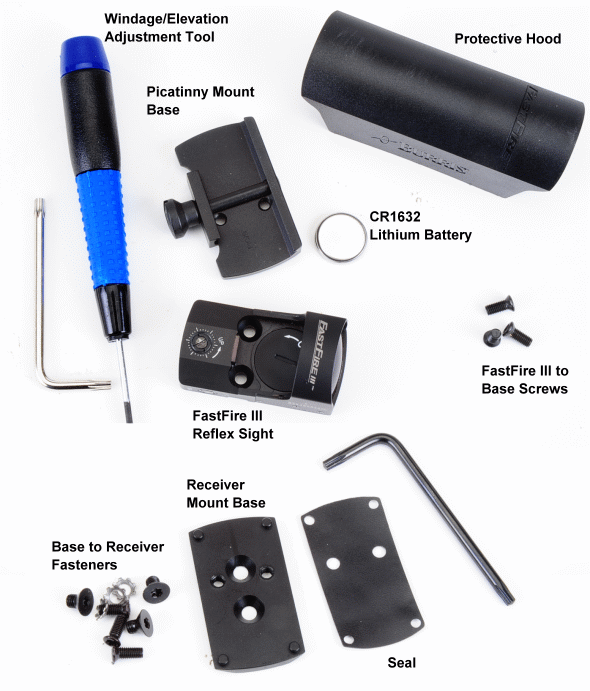
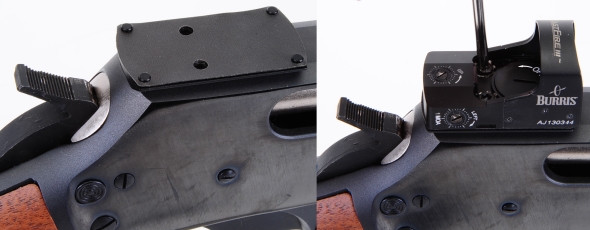
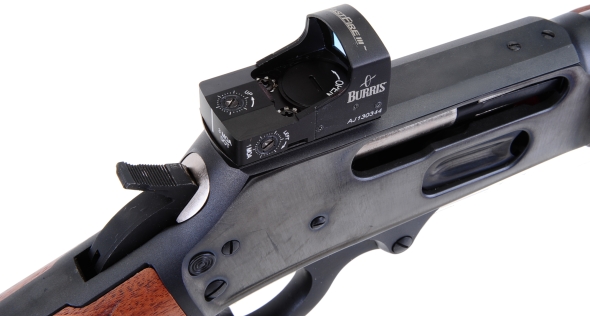

Email Notification